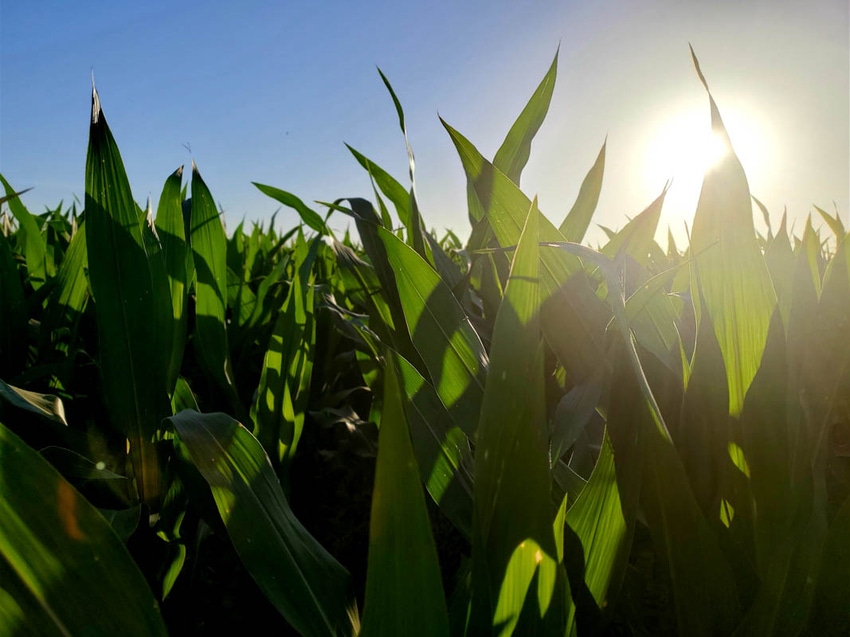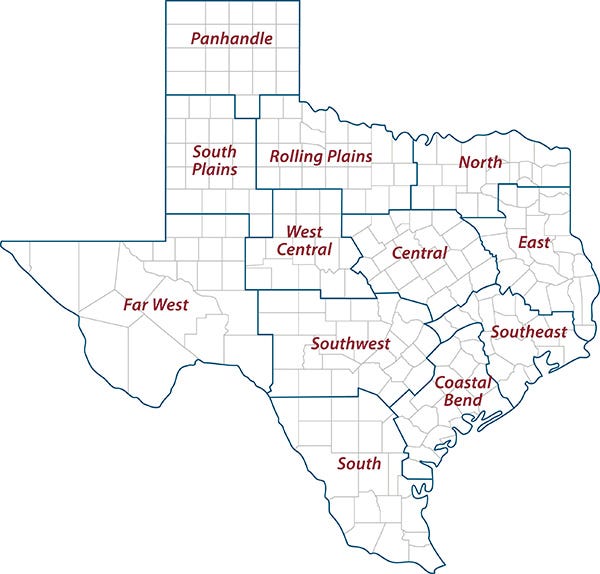
Weather went from extremely wet to extremely hot and dry across most of Texas, according to the Texas State Climatologist.
Dr. John Nielsen-Gammon, College Station, said the weather turned from record-breaking rainfall in the spring to one of the driest and hottest summers on record. The jet stream migrated north, away from Texas, and tropical thunderstorms didn’t deliver in the summer months either, as temperatures continued a 1 to 2 degrees warmer long-term trend.

“A lot of the state picked up rain in June, after a very wet spring,” he said. “But then it started getting dry.”
A large swath of the state from the Lower Rio Grande Valley to Midland and Lubbock, the Hill Country up Interstate 35 to Dallas and much of East Texas has received less than 1 inch of rain since July 1, he said.
Some parts of the state, including around Beaumont and parts of the Panhandle, remained relatively wet, but Nielsen-Gammon said those areas are scattered.
“The monsoon season in West Texas was below normal with some parts receiving 2-3 inches, but it was spotty,” he said.
The state averaged 1.9 inches of rain total in July and August so far, which would make 2019 the third driest period behind 2000 and 2011 if no further rain fell, he said.
Nielsen-Gammon said the lack of moisture has allowed temperatures to climb.
“It’s been warm too,” he said. “The average temperature for the first 18 days of August has been the hottest on record for much of West Texas and some coastal areas. Temperatures have been in the top five hottest everywhere else except north-central and northeast Texas.”
Nielsen-Gammon said 95 record high temperatures had been set, and 88 high-temperature records had been tied at reporting stations around the state in August.
The drought monitor shows 22 percent of the state is in drought and 45 percent of Texas is abnormally dry, he said.
Texas A&M Forest Service Outdoor Burn Ban monitor showed 132 of 254 counties were prohibiting fires of any kind as of Aug. 20. The agency’s Keetch-Byram Drought Index, which measures drought and fire potential, has continued to climb around the state.
Nielsen-Gammon said some areas, including the Panhandle and parts of southwest Texas, have “opportunities for rain” in the near future, but he expects neutral weather conditions to persist into the fall.
“There are no indications of an El Niño or La Niña pattern, so it will be a flip of the coin on weather,” he said. “It shouldn’t be exceptionally dry or exceptionally wet.”
AgriLife Extension district reporters compiled the following summaries:

CENTRAL: Rains gave rangelands and pastures a drink but not enough, and hay feeding ramped up. It was a good year for hay production and producers were still cutting and baling. Extremely hot temperatures were reported, and all counties needed moisture. Livestock were in good condition. Crop harvests were nearly complete with above average yields in some areas. Harvest of corn and grain sorghum continued. Livestock conditions were declining due to heat and drought. Water tanks were filled during the wet spring, so water was not a problem. However, pastures dried down significantly, and the blackland soils were cracking everywhere. Producers needed some moisture to plow up small grain seedbeds in preparation to plant. Nearly all counties reported short soil moisture levels. Overall rangeland, pasture and crop conditions were fair in nearly all counties.
ROLLING PLAINS: The district experienced another hot and windy week with a few areas receiving much-needed rain. Cotton fields were blooming. Pastures and rangelands needed moisture with conditions ranging from poor to good. Several wildfires were reported.
COASTAL BEND: Most areas reported hot and humid weather with no rain. Colorado County reported scattered showers. Soil moisture levels continued to decline. Burn bans were in effect in many areas. Corn, cotton and rice harvests were in full swing, though many cotton acres remained. Several farmers were waiting to harvest a rice ratoon crop. Average to above-average yields were reported with most crops. Soybean harvest began, but quality losses were likely due to a lack of rainfall in the last 30-plus days. Growers were also busy with post-harvest fieldwork. Rangelands and pastures were extremely dry and continued to decline in quality and quantity. Some grazed pastures were running short, but livestock were still in good condition. Many producers started supplemental feeding with some just utilizing protein, while others started feeding hay. Some producers sold off some cattle, but a recent price drop may cause others to wait and see if the market rebounds.
EAST: The lack of rain and extreme heat caused a rapid decline in pastures, hay meadows and vegetable crops across most of the district. Pasture and rangeland conditions were fair. Subsoil was adequate, while topsoil conditions were short. Livestock conditions were fair to good. Anderson County reported cattle were in good condition with producers supplementing protein. Cattle market prices took a big dip from previous weeks. Armyworms and Bermuda grass stem maggots were reported. Cherokee County reported that Bermuda grass stem maggots had been a bigger problem than normal. Wild pigs continued to cause damage.
SOUTH PLAINS: Dry conditions continued. The cotton crop needed rainfall as plants were flowering in many areas. Cotton farmers were starting to pull back on irrigation to allow plants to finish maturing. Other producers were continuing to irrigate to keep up with the heat. Producers also continued to keep an eye on the insects beginning to show on crops. Pumpkins were emerging. Beef cattle were in good condition because of the spring and early summer rains on grazing lands, but pastures were getting very short.
PANHANDLE: Temperatures were in the triple digits across the district. The heat-stressed crops, rangeland and livestock. Corn and cotton were in fair condition across the district. Corn, sorghum and cotton were three to four weeks behind in the northern panhandle. Subsoil and topsoil were short across the district. Rangelands and livestock were in poor condition due to the continued heat.
NORTH: A few counties reported adequate soil moisture, but most reported short to very short conditions. Temperatures were around 100 degrees with winds 5-10 mph. Rain showers were spotty with up to 2 inches in some locations and no rain in the forecast. Soils were cracking. Pastures were in decent shape but were starting to show signs of heat stress. Some tanks were beginning to shrink. Hay harvest continued. Wild pig activity was light. Armyworms were showing up in fields.
FAR WEST: Average high temperatures were in the 100s with lows in the mid-70s. Scattered showers delivered up to 0.5 to 1 inch of rain. High winds and dry conditions were contributing to poor cotton crop conditions with reports of fields wilting in eastern parts of the district. Upland cotton in northwest areas were doing well. Minimal pest pressures were reported, though the district had seen an outbreak of stink bugs and some boll worms. Stink bugs damaged some younger bolls, mainly in Upland cotton, and not so much in Pima cotton. Some cow/calf producers were expecting to ship cattle within the next two weeks. Hay producers continued to make hay under ideal conditions. Pecan weevil traps were placed and tracked in preparation to spray. There was a high alert for fire danger due to heavy spring and early summer growth now turning to fuel. More than 8,000 acres has burned in the district so far. Producers continued to feed livestock and wildlife. Dove season was around the corner.
WEST CENTRAL: Very hot and dry conditions continued to persist. Forage and hay crops were stressed by drought. Fire conditions continued to increase. Cotton was in mostly fair condition. Grain sorghum harvest was underway. Sugarcane aphids continued to be an issue in isolated areas. Stock tank levels continued to decline but were not critical yet. Sheep and goat markets were steady, but the cattle market was down.
SOUTHEAST: Brazos County reported very high temperatures. Conditions were dry, and burn bans were being implemented or considered. Livestock were in good condition despite the dry conditions. Rangeland and pasture ratings were excellent to very poor, with fair being most common. Soil moisture levels ranged from adequate to very short, with short being most common.
SOUTHWEST: Some areas received rain, but not nearly enough to help drought-stricken counties. Temperatures were mostly in the upper 90s and exceeded 100 degrees. Conditions were drying very rapidly. Some wildfires were reported, and anthrax continued to be a concern for some counties. Rangeland and pasture conditions were declining. Many stock tanks were reaching critical levels, and streams and creeks were very low to dry. Corn harvest was complete or nearing the end for most producers.
SOUTH: Conditions were hot and dry with short to very short soil moisture levels. Some counties were experiencing severe drought conditions. Temperatures were over 100 degrees in most areas. Dimmit County reported a high temperature of 112 degrees. Cotton and peanuts were progressing quickly with the warmer temperatures. Peanut fields were setting pods and were under irrigation. Cotton bolls were opening while producers in other areas were defoliating or had completed harvest. Cotton harvest continued in Jim Wells County with fair to average yield reports. Rangeland and pasture conditions were deteriorating rapidly. Pastures were browning, and some producers started feeding hay. Some producers began to cull herds or move them to other pastures. Watermelon and cantaloupe harvests were almost complete. Coastal Bermuda grass fields were producing good hay bales. Producers reported supplemental feeding of livestock was underway in some parts. Corn harvest was active and neared completion in some areas. Pecans made good progress with no insect pressures reported. Deer breeders were providing supplemental feed. Some ranchers were providing water for livestock and wildlife.
Source: is AgriLife TODAY, which is solely responsible for the information provided and is wholly owned by the source. Informa Business Media and all its subsidiaries are not responsible for any of the content contained in this information asset.
About the Author(s)
You May Also Like




